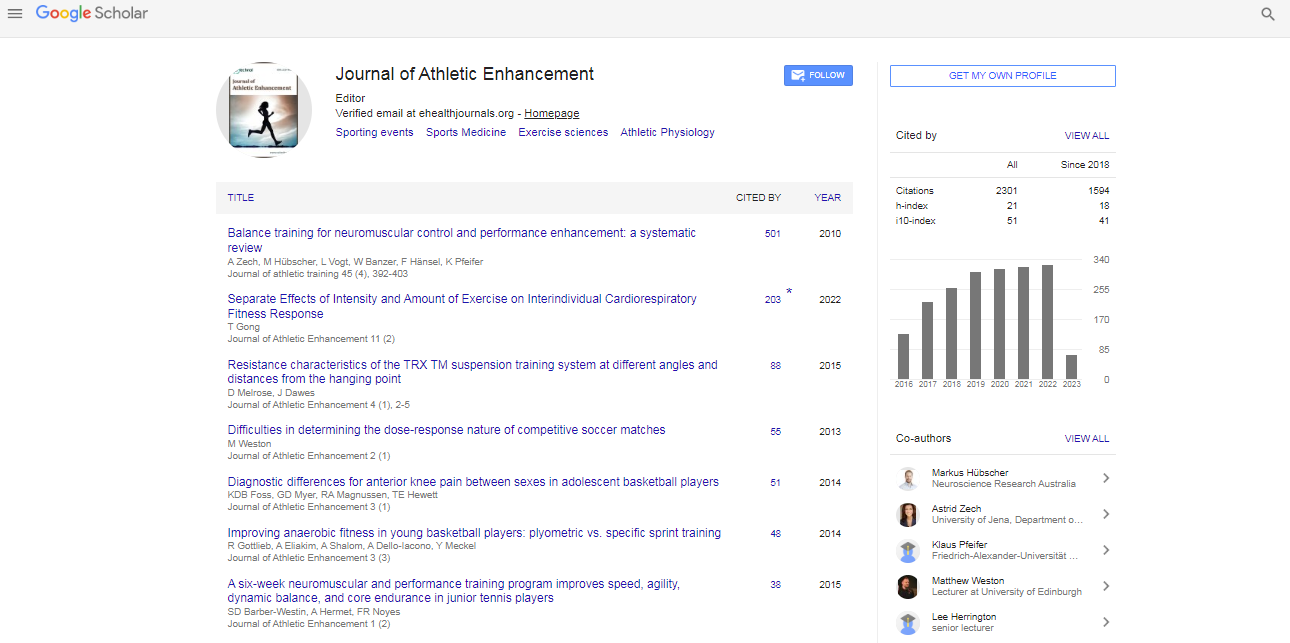Perspective, J Athl Enhanc Vol: 13 Issue: 3
Exploring the Science of Exercise: A Comprehensive Overview
Mountjoy Kay*
1Department of Sports, University of Sydney, Sydney, Australia
*Corresponding Author: Mountjoy Kay,
Department of Sports, University of
Sydney, Sydney, Australia
E-mail: kaymountjoy@edu.au
Received date: 26 April, 2024, Manuscript No. JAE-24-137883;
Editor assigned date: 29 April, 2024, PreQC No. JAE-24-137883 (PQ);
Reviewed date: 14 May, 2024, QC No. JAE-24-137883;
Revised date: 20 May, 2024, Manuscript No. JAE-24-137883 (R);
Published date: 27 May, 2024, DOI: 10.4172/2324-9080.1000132
Citation: Kay M (2024) Exploring the Science of Exercise: A Comprehensive Overview. J Athl Enhanc 13:3.
Description
Exercise science is a multidisciplinary field that delves into the physiological, biomechanical, and psychological aspects of physical activity and exercise. It encompasses a wide range of disciplines, including physiology, biomechanics, kinesiology, psychology, and nutrition, among others. The primary focus of exercise science is to understand how the human body responds and adapts to physical activity, with the ultimate goal of improving health, performance, and quality of life. One of the fundamental areas of study within exercise science is exercise physiology, which examines how the body responds to exercise at the cellular and systemic levels. This includes the cardiovascular, respiratory, muscular, and metabolic responses to various types and intensities of exercise. For example, researchers investigate how the heart and lungs adapt to aerobic exercise, how muscles generate force during resistance training, and how the body utilizes energy substrates during different forms of physical activity.
Understanding these physiological responses is crucial for designing effective exercise programs tailored to individual needs and goals. It also provides insights into the mechanisms underlying the health benefits of regular physical activity, such as improved cardiovascular function, enhanced metabolic health, and increased muscular strength and endurance. Biomechanics is another key aspect of exercise science, focusing on the mechanics of human movement and the interaction between the body and external forces. By applying principles of physics and engineering, bio-mechanists analyze movements such as walking, running, jumping, and lifting weights to optimize performance, prevent injuries, and enhance rehabilitation strategies.
Through advanced technologies like motion capture systems and force platforms, researchers can precisely measure and analyze movement patterns, joint kinetics, and muscle activation patterns. This information is invaluable for athletes looking to improve their technique, coaches seeking to optimize training programs, and healthcare professionals aiming to design effective rehabilitation protocols for injured individuals. In addition to physiological and biomechanical considerations, exercise science also explores the psychological aspects of physical activity and exercise behavior. This includes motivations for exercise participation, adherence to exercise programs, and the psychological benefits of regular physical activity on mental health and well-being.
Nutrition plays a critical role in exercise performance, recovery, and overall health. Exercise scientists study the complex interplay between nutrition and physical activity, exploring topics such as energy balance, macronutrient requirements, hydration strategies, and the timing of nutrient intake in relation to exercise. Whether it's optimizing carbohydrate intake for endurance athletes, ensuring adequate protein consumption for muscle repair and growth, or developing personalized nutrition plans for weight management and body composition goals, exercise scientists provide evidence-based recommendations to support optimal performance and health outcomes.
Exercise science has important implications for clinical populations, including individuals with chronic diseases, disabilities, or injuries. Through exercise-based interventions, healthcare professionals can improve functional capacity, manage symptoms, and enhance the quality of life for patients with conditions such as cardiovascular disease, diabetes, obesity, musculoskeletal disorders, and mental health disorders. Exercise science is a dynamic and interdisciplinary field that encompasses a broad range of topics related to physical activity, health, and human performance. By integrating knowledge from physiology, biomechanics, psychology, nutrition, and other disciplines, exercise scientists strive to enhance our understanding of how the body responds to exercise and how we can optimize health, performance, and well-being through physical activity.
From elite athletes striving for peak performance to individuals seeking to improve their health and fitness, the insights gained from exercise science research have far-reaching implications for promoting active lifestyles and enhancing human potential. As technology continues to evolve and our understanding of human physiology deepens, the future of exercise science holds exciting possibilities for improving lives and transforming the way we approach exercise and physical activity.
 Spanish
Spanish  Chinese
Chinese  Russian
Russian  German
German  French
French  Japanese
Japanese  Portuguese
Portuguese  Hindi
Hindi 
